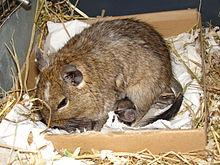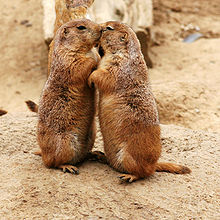This is an old revision of this page, as edited by Cryptic (talk | contribs) at 23:46, 20 April 2021 (source is a painfully obvious infringement of the 26 April 2017 version of Prairie dog). The present address (URL) is a permanent link to this revision, which may differ significantly from the current revision.
Revision as of 23:46, 20 April 2021 by Cryptic (talk | contribs) (source is a painfully obvious infringement of the 26 April 2017 version of Prairie dog)(diff) ← Previous revision | Latest revision (diff) | Newer revision → (diff)| This article is an orphan, as no other articles link to it. Please introduce links to this page from related articles; try the Find link tool for suggestions. (April 2021) |
Communal burrow refers to the habitat built by some species of mammals as a community habitat. there are some species that build burrows, but not communal burrows; and there are some species that live in groups, but do not construct burrows or any other type of habitat.
Overview
A burrow is a hole or tunnel excavated into the ground by an animal to create a space suitable for habitation, temporary refuge, or as a byproduct of locomotion. Burrows provide a form of shelter against predation and exposure to the elements and can be found in nearly every biome and among various biological interactions. Many different animal species are known to form burrows. These species range from small invertebrates, such as the Corophium arenarium, to very large vertebrate species such as the polar bear. Burrows can be constructed into a wide variety of substrates and can range in complexity from a simple tube a few centimeters long to a complex network of interconnecting tunnels and chambers hundreds or thousands of meters in total length. An example of this well-developed burrow would be a rabbit warren.
Types of burrows

Animals can create burrows using a variety of methods. Burrowing animals can be divided into three categories: primary excavators, secondary modifiers and simple occupants. Primary excavators are the animals that originally dig and construct the burrow, and are generally very strong. Some animals considered to be primary excavators are the prairie dog and the aardvark. Pygmy gerbil are an example of secondary modifiers, as they do not build an original burrow, but will live inside a burrow made by other animals and improve or change some aspects of the burrow for their own purpose. The third category, simple occupants, neither build nor modify the burrow but simply live inside or use it for their own purpose. Some species of Bird will actually make use of burrows built by tortoises, which is an example of simple occupancy. These animals can also be referred to as commensals.
Specific species
Common degus
Common degus are highly social. They live in burrows, and, by digging communally, they are able to construct larger and more elaborate burrows than they could on their own. Degus digging together coordinate their activities, forming digging chains. Females living in the same group have been shown to spontaneously nest communally; they nurse one another's young. They spend a large amount of time on the surface, where they forage for food. When foraging, their ability to detect predators is increased in larger groups, and each animal needs to spend less time in vigilance.
Common degus exhibit a wide array of communication techniques. They have an elaborate vocal repertoire comprising up to 15 different sounds, and the young need to be able to hear their mother's calls if the emotional systems in their brains are to develop properly. They use their urine to scent mark, and experiments have shown that they react to one another's marks, although in males the hormone testosterone may suppress their sense of smell somewhat.

Common degus are seasonal breeders; the breeding season for wild degus begins in the Chilean autumn when day and night are roughly equal, with pups born in early to mid-spring.
Common degu pups are born relatively precocial, fully furred and with eyes open, and their auditory and visual systems are functional at birth. Unlike most other rodents, male common degus also take part in protecting and raising their pups until they are old enough to leave the family.
Plains viscacha
Plains viscacha live in communal burrow systems in groups containing one or more males, several females, and immatures. Viscachas forage in groups at night and aggregate underground during the day. All members of a group use burrows throughout the communal burrow system and participate in digging at the burrows. Alarm calls are given primarily by adult males. The long-term social unit of the plains viscacha is the female group. Resident males disappear each year and new males join groups of females. Viscachas live in colonies that range from a few individuals to hundreds. To keep up with the colony chatter, they have acquired an impressive repertoire of vocalizations that are used in social interactions. Dominance is absent among females. Members of a social group share a common foraging area around the communal burrow system, and feed on a variety of grasses and forbs, occasionally browsing on low shrubs. They collect branches and heavy objects to cover the burrow entrance. When they live close to human settlements, tend to hoard brooms, tables, garden tools, firewood, trinkets, pieces of concrete, and many human-made objects to cover the burrow.
Daurian pikas
Daurian pikas have been observed sharing burrows with several other mammal species. They occasionally “visit” burrows of Altai marmots and Mongolian pikas. In turn, their burrows are visited by ground squirrels, and sometimes by burrowing birds. Due to low competition and predation rates, the limiting factor on Daurian pika populations is winter.
Prairie dogs

Highly social, prairie dogs live in large colonies or "towns" and collections of prairie dog families that can span hundreds of acres. The prairie dog family groups are the most basic units of its society. Members of a family group inhabit the same territory. Family groups of black-tailed and Mexican prairie dogs are called "coteries", while "clans" are used to describe family groups of white-tailed, Gunnison’s, and Utah prairie dogs.Although these two family groups are similar, coteries tend to be more closely knit than clans. Members of a family group interact through oral contact or "kissing" and grooming one another. They do not perform these behaviors with prairie dogs from other family groups.

A prairie dog town may contain 15–26 family groups. There may also be subgroups within a town, called "wards", which are separated by a physical barrier. Family groups exist within these wards. Most prairie dog family groups are made up of one adult breeding male, two to three adult females and one to two male offspring and one to two female offspring. Females remain in their natal groups for life and are thus the source of stability in the groups. Males leave their natal groups when they mature to find another family group to defend and breed in. Some family groups contain more breeding females than one male can control, so have more than one breeding adult male in them. Among these multiple-male groups, some may contain males that have friendly relationships, but the majority contain males that have largely antagonistic relationships. In the former, the males tend to be related, while in the latter, they tend not to be related. Two to three groups of females may be controlled by one male. However, among these female groups, there are no friendly relations.
The average prairie dog territory takes up 0.05–1.01 hectares (0.12–2.50 acres). Territories have well-established borders that coincide with physical barriers such as rocks and trees. The resident male of a territory defends it and antagonistic behavior will occur between two males of different families to defend their territories. These interactions may happen 20 times per day and last five minutes. When two prairie dogs encounter each other at the edges of their territories, they will start staring, make bluff charges, flare their tails, chatter their teeth, and sniff each other's perianal scent glands. When fighting, prairie dogs will bite, kick and ram each other. If their competitor is around their size or smaller, the females will participate in fighting. Otherwise, if a competitor is sighted, the females signal for the resident male.
See also
References
- Jones, S. E.; Jago, C. F. (1993-01-01). "In situ assessment of modification of sediment properties by burrowing invertebrates". Marine Biology. 115 (1): 133–142. doi:10.1007/BF00349395. ISSN 1432-1793. S2CID 85234722.
- Jonkel, Charles J.; Kolenosky, George B.; Robertson, Richard J.; Russell, Richard H. (1972). "Further Notes on Polar Bear Denning Habits". Bears: Their Biology and Management. 2: 142–158. doi:10.2307/3872578. ISSN 1936-0614. JSTOR 3872578.
- Mukherjee, Aditi., Pilakandy, Rajan., Kumara Honnavalli Nagaraj., Manchi, Shirish S., Bhupathy, Subramanian. (June 2017). "Burrow characteristics and its importance in occupancy of burrow dwelling vertebrates in Semiarid area of Keoladeo National Park, Rajasthan, India". Journal of Arid Environments. 141: 7–15. Bibcode:2017JArEn.141....7M. doi:10.1016/j.jaridenv.2017.02.003.
{{cite journal}}: CS1 maint: multiple names: authors list (link) - ^ Kinlaw, Al (1999). "A review of burrowing by semi-fossorial vertebrates in arid environments". Journal of Arid Environments. 41 (2): 127–145. Bibcode:1999JArEn..41..127K. doi:10.1006/jare.1998.0476 – via Elsevier Science Direct.
- Ebensperger, L. A.; Bozinovic, F. (2000), "Communal burrowing in the hystricognath rodent, Octodon degus: A benefit of sociality?", Behavioural and Ecological Sociobiology, 47 (5): 365–369, doi:10.1007/s002650050678, hdl:10533/172245, ISSN 0340-5443, S2CID 12859012
- ^ Ebensperger, L. A.; Bozinovic, F. (2000b), "Energetics and burrowing behaviour in the semifossorial degu Octodon degus (Rodentia: Octodontidae)", Journal of Zoology, 252 (2): 179–186, doi:10.1111/j.1469-7998.2000.tb00613.x, hdl:10533/172199
- Ebensperger, L.A.; Veloso, C.; Wallem, P. (2002), "Do female degus communally nest and nurse their pups?", Journal of Ethology, 20 (2): 143–146, doi:10.1007/s10164-002-0063-x, ISSN 0289-0771, S2CID 38854503
- Ebensperger, L.A.; Hurtado, M.; Lacey, E.; Chang, A.; Chang, AT (2004), "Communal nesting and kinship in degus (Octodon degus)", Naturwissenschaften, 91 (8): 391–395, Bibcode:2004NW.....91..391E, doi:10.1007/s00114-004-0545-5, hdl:10533/175502, ISSN 0028-1042, PMID 15309311, S2CID 929721
- Quirici, V.; Castro, R.A.; Oyarzun, J.; Ebensperger, L.A. (2008), "Female degus (Octodon degus) monitor their environment while foraging socially", Anim Cogn, 11 (3): 441–448, doi:10.1007/s10071-007-0134-z, ISSN 1435-9448, PMID 18214556, S2CID 17723026
- Long, C.V. (2007), "Vocalisations of the degu (Octodon degus), a social caviomorph rodent", Bioacoustics, 16 (3): 223–244, doi:10.1080/09524622.2007.9753579, ISSN 0952-4622, S2CID 84569309
- Ziabreva, I.; Schnabel, R.; Poeggel, G.; Braun, K. (2003), "Mother's voice "buffers" separation-induced receptor changes in the prefrontal cortex of Octodon degus", Neuroscience, 119 (2): 433–441, doi:10.1016/S0306-4522(03)00123-4, PMID 12770557, S2CID 28635328
- Kleiman, D.G. (1974), "Patterns of behaviour in hystricomorph rodents", in Rowlands, I. W.; Weir, B. J. (eds.), The Biology of Hystricomorph Rodents, London: Academic Press
- Fischer, R.; Meunier, G. (1985), "Responses to conspecifics' urine by the degu Octodon degus", Physiological Behaviour, 34 (6): 999–1001, doi:10.1016/0031-9384(85)90027-7, PMID 4059390, S2CID 27846946
- Jechura, T.; Walsh, J.; Lee, T. (2003), "Testosterone suppresses circadian responsiveness to social cues in the diurnal rodent Octodon degus", Journal of Biological Rhythms, 18 (1): 43–50, doi:10.1177/0748730402239675, PMID 12568243, S2CID 40262270
- Ebensperger, L.A.; Caiozzi, A. (2002), "Male degus, Octodon degus, modify their dustbathing behaviour in response to social familiarity of previous dustbathing marks", Revista Chilena de Historia Natural, 75: 157–163, doi:10.4067/S0716-078X2002000100015, ISSN 0716-078X
- Bozinovic, F.; Bacigalupe, L.; Vasquez, R.; Visser, H.; Veloso, C.; Kenagy, G. (2004), "Cost of living in free-ranging degus (Octodon degus): Seasonal dynamics of energy expenditure", Comparative Biochemistry and Physiology A, 137 (3): 597–604, doi:10.1016/j.cbpb.2003.11.014, PMID 15123196
- Reynolds, T.; Wright, J. (1979), "Early postnatal physical and behavioural development of degus (Octodon degus)", Lab Animal, 13 (2): 93–9, doi:10.1258/002367779780943576, PMID 480906, S2CID 22769488
- "Breeding Degus". Exoticnutrition.com. Retrieved 20 May 2019.
- http://www.conservacionpatagonica.org/blog/2011/06/29/species-profile-mountain-vizcacha/
- Branch L. 1993. Social organization and mating system of the plains vizcacha (Lagostomus maximus). J Zool (Lond). 229:473–491
- Giulietti J, Jackson J. 1986. Composición anual de la dieta de la vizcacha (Lagostomus maximus) en pastizales naturales en la provincia de San Luís, Argentina. Rev Argent Prod Anim. 6:229–237.
- Eshelkin, I, and S.M. Purtov. "Mobility and contact between animals in the Gorno-Altai natural plague nidus." The Soviet journal of ecology Nov/Dec.7 (1976): 556-558. Print.